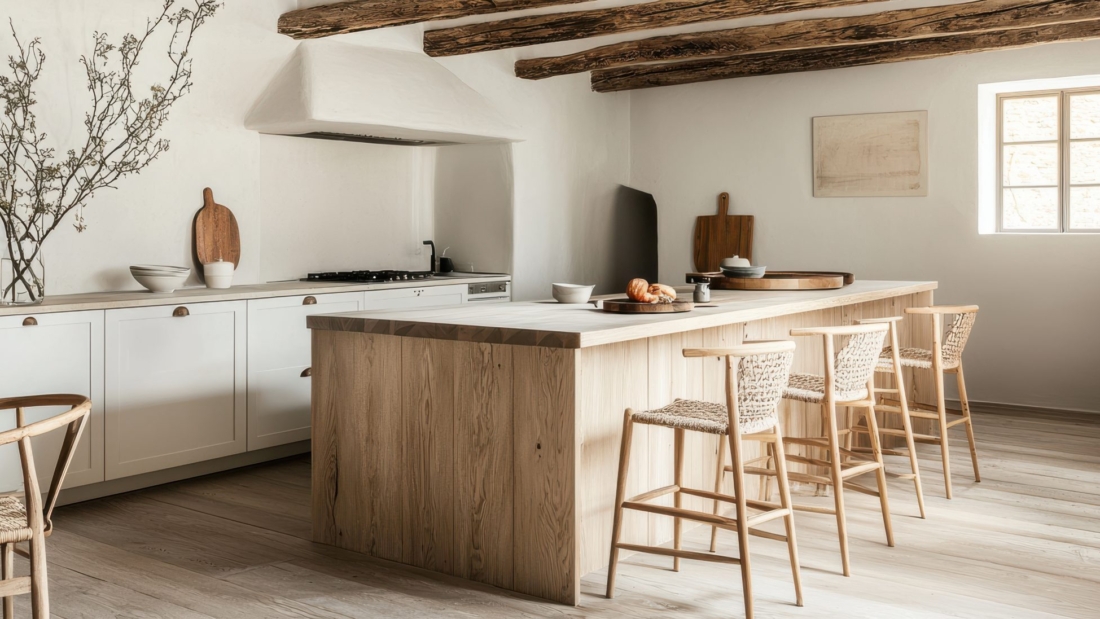Japandi style has become a quiet yet powerful movement in the world of interior design. Unless you regularly read design publications or follow home decor trends, it might have flown under your radar—until now.
This unique aesthetic is gaining attention for its refined beauty, practical approach, and calming atmosphere. So, what exactly is Japandi, and how can you bring it into your kitchen?
What is Japandi Design?
At its core, Japandi is a harmonious fusion of Japanese and Scandinavian design principles. It merges the Zen-like serenity and minimalism of Japanese interiors with the warmth, coziness, and functionality of Scandinavian style.
Japanese influence offers clean lines, natural materials, and a peaceful, uncluttered ambiance. Scandinavian design contributes soft textures, muted tones, and an inviting, lived-in warmth known as hygge. The combination is simple yet sophisticated—a perfect balance between elegance and practicality.
Why Japandi Is Perfect for Kitchens
The kitchen is a central space in any home. Japandi’s calm and purposeful style creates a space that’s not just functional but emotionally comforting. With its clean aesthetics and natural palette, a Japandi kitchen becomes a tranquil, clutter-free retreat from the pace of everyday life.
This style is rooted in timeless principles—balance, simplicity, and sustainability—making it much more than a passing trend. It’s designed to last, both in appeal and durability.
The Origins of Japandi Style
Though Japandi has only recently entered mainstream conversation, its foundation was laid more than a century ago. In the late 19th century, Scandinavian designers began to draw inspiration from Japanese aesthetics. Both cultures value minimalism, craftsmanship, and a strong connection to nature—creating a natural synergy between the two.
Similarities and Differences: Japan Meets Scandinavia
Similarities:
-
A focus on functionality
-
The use of high-quality, natural materials
-
Strong connection to the outdoors
-
Simplicity in form and color
Differences:
-
Japanese design favors darker woods and bolder colors.
-
Scandinavian design leans toward soft pastel tones and lighter woods.
Japandi embraces both, combining clean white walls and pale woods with deep, earthy hues and handcrafted decor elements.
How to Create a Japandi-Inspired Kitchen
If you’re inspired to bring Japandi into your kitchen, here are the key elements to focus on:
1. Prioritize Space and Light
Japandi design thrives on openness and airiness. Let in as much natural light as possible and avoid heavy window treatments. Opt for handleless cabinetry with sleek, minimalist lines. The less visual noise, the better.
2. Embrace a Soft, Neutral Palette
Use muted, natural tones such as warm beiges, soft greys, pale blues, or dusty pinks. White cabinetry is a staple, often contrasted with deeper, Japanese-inspired accents like charcoal or espresso wood. Metallic fixtures in brushed gold or matte black can add a refined edge.
3. Incorporate Natural Materials and Textures
Think stone, wood, clay, and woven fibers. Choose durable surfaces like quartz or natural stone for countertops, and integrate wood elements like oak, walnut, or bamboo for cabinetry or shelving. Add soft textures through linen curtains, wool rugs, or jute mats for a cozy Scandinavian layer.
4. Highlight Craftsmanship
Both Japanese and Scandinavian design emphasize quality craftsmanship. Choose simple but beautifully made pieces. Whether it’s custom cabinetry, hand-thrown ceramic dishware, or artisan lighting, every element should feel intentional and well-crafted.
5. Bring the Outside In
Introduce indoor greenery with houseplants like ferns, bonsai, or trailing vines. These natural touches soften the space and reinforce the connection with the outdoors.
6. Keep It Minimal
Clutter undermines the calming essence of Japandi. Adopt a “less is more” mindset. Open shelving should be curated, surfaces kept clear, and storage solutions streamlined. Let every item serve a purpose.
7. Aim for Balance and Harmony
The ultimate goal is to create a kitchen that feels calm, functional, and balanced. Avoid over-decorating or forcing contrasts. Instead, choose elements that naturally complement one another in tone, texture, and placement.
Final Thoughts
Japandi kitchens aren’t about flash or ornament. They’re about quiet beauty, natural balance, and living intentionally. By blending the peaceful minimalism of Japan with the warm practicality of Scandinavia, you can create a kitchen that not only looks stunning but also nourishes a sense of wellbeing in daily life.
If you’re looking to transform your kitchen into a space that brings calm, simplicity, and timeless design into your home—Japandi is the way forward.

